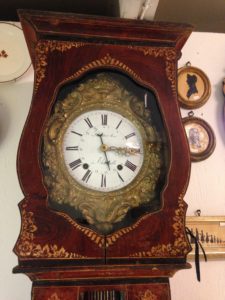Comtoise clocks’ rich history
These intricate gorgeous clocks, known as Comtoise, Morbier or Morez clocks, are a style of longcase clock made in the Jura region, mountains on the French–Swiss border. Production of these clocks began in 1680 and continued for a period of about 230 years. During the peak production years (1850–1890) over 60,000 clocks were made each year.
At first made exclusively by clockmakers, later the farmers from the hamlets and villages around Morez and Morbier and the employees of the workshops, had clock parts delivered in roughly cast condition. Each group of farmers had its specific activity. One family turned arbors the entire winter, while the other manufactured wheelworks and hammer arbors. This division of work has had a very positive influence on the final result: a perfect finish of the parts.
In the workshops the smiths made the frames, posts and other parts of iron. When all parts were made, the “engreneur” (the gear-man of the clockwork) assembled the product. The “rhabilleur”, literally the repairer, finally puts the clock into motion.
 After 1860 the home workers were deprived of their living and independent small factories arise, that execute the entire production process themselves. Remarkably, other clockmakers in the Jura made their mark in this period.
After 1860 the home workers were deprived of their living and independent small factories arise, that execute the entire production process themselves. Remarkably, other clockmakers in the Jura made their mark in this period.





